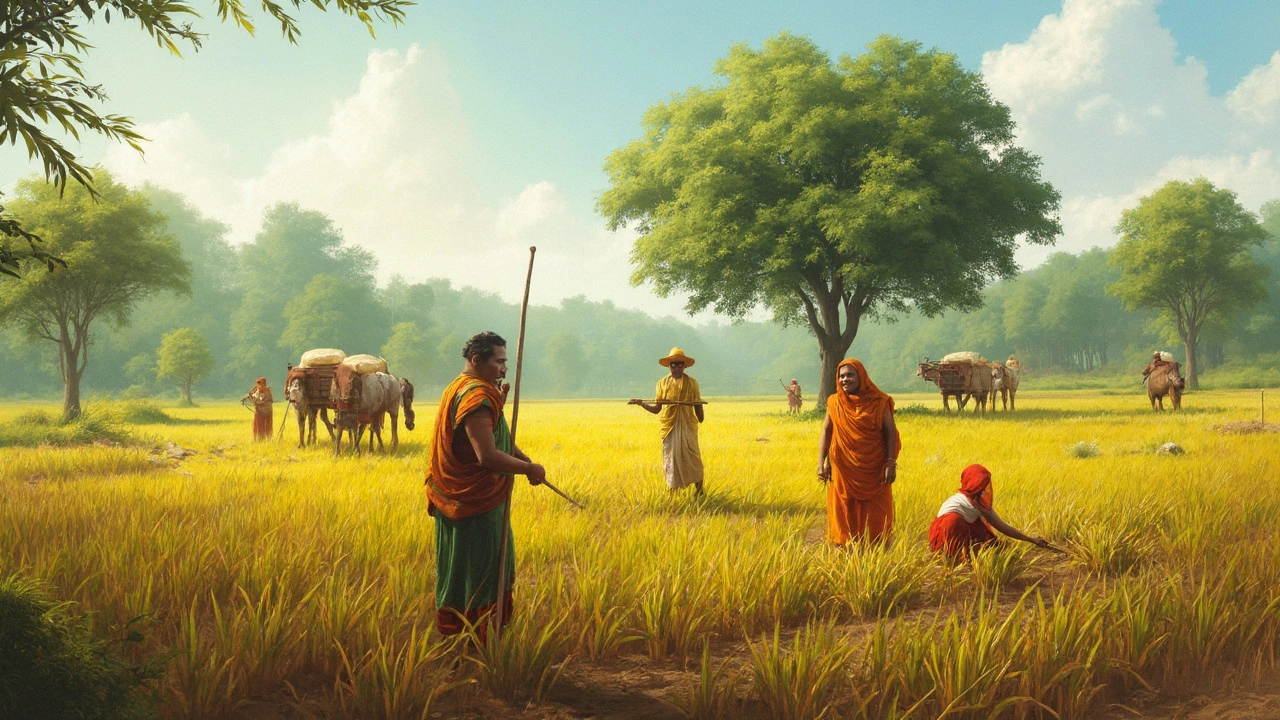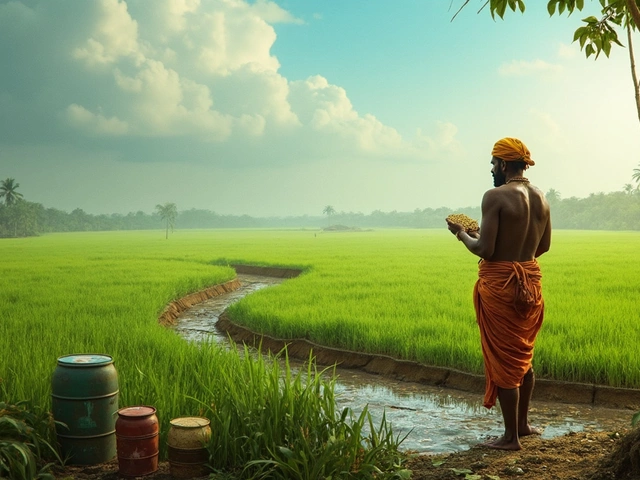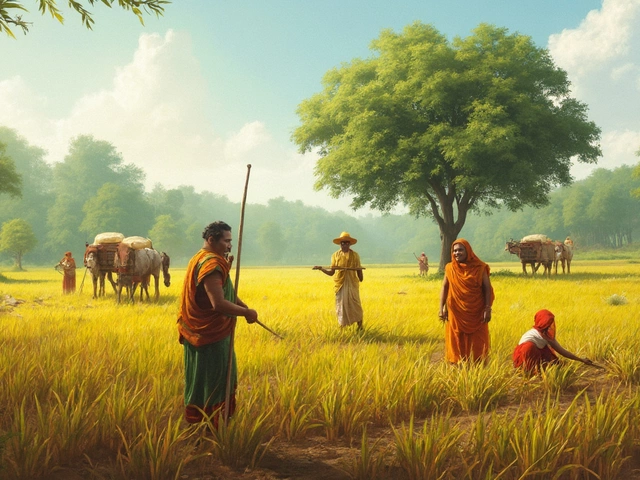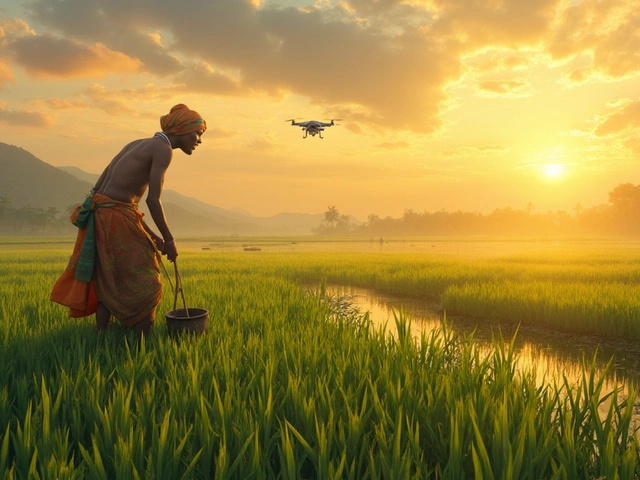Most folks picture rice growing in knee-deep water, but that's not the only option. Believe it or not, you can plant rice on dry land too. It isn't exactly a walk in the park—there are some real challenges. But if you pick the right kind of rice and treat your soil well, dryland rice farming can feed families and communities where paddies just won't work.
The secret? Upland rice. This type of rice doesn't need standing water. It grows up on hillsides or flat fields, more like wheat or corn. If you live in a place with limited water or hilly land, this could be a total game-changer. But it's not just about choosing a different seed—what you do with your soil, your field layout, and how you fight off weeds matters even more here.
- Rice Myths: Wet Paddies vs. Dry Land
- Meet Upland Rice
- Picking the Right Spot and Preparing Dry Fields
- Soil Health and Water Matters
- Seeds, Weeding, and Pests
- What Works: Farmers Doing Dryland Rice Right
Rice Myths: Wet Paddies vs. Dry Land
Most people think of rice and instantly picture it floating in muddy water. Here’s the deal: not all rice needs to be flooded. Traditional images of barefoot farmers standing in paddies only show one side of the story. The truth is, rice is grown both in water and on dry land—sometimes even on steep hills where flooding isn’t possible.
Why do people flood rice fields in the first place? In a nutshell, standing water stops weeds from taking over and keeps bugs in check. It’s also great for controlling the temperature, especially in hot or dry climates. But keeping fields flooded means farmers need lots of water and flat land, which just isn’t an option for everyone.
Now, here’s a fact that surprises many: about 13% of the world’s rice comes from upland fields—where water doesn’t sit around and soil drains naturally. This ‘upland rice’ is grown mostly in Africa, parts of Southeast Asia, and South America. Instead of planting seeds in a flooded field, farmers sow seeds directly into dry soil and hope for regular rain.
Before you start thinking upland rice equals easy, hold up. These dry fields can be a headache. There’s more weeding, and crops get thirsty way faster. But for millions of people without easy access to irrigation, dryland rice is a lifeline.
- Flooded rice fields suppress weeds, but upland rice growers have to manage weeds by hand or with mulch.
- Upland rice usually needs different seeds, specially bred for drought and fast-growing roots.
- Yields in dry land rice farming tend to be lower, unless farmers use clever tricks to save water and feed their soil.
Meet Upland Rice
Upland rice has been quietly feeding people in Asia, Africa, and South America for centuries, yet hardly anyone talks about it outside farming circles. Unlike paddy rice, it doesn’t need a flooded field. You plant it straight into regular soil, just like corn or beans. Upland rice is a lifesaver in places where water is tight or the ground is too sloped for paddies.
The coolest thing? Upland rice comes from the same species as other rice types (Oryza sativa), but farmers have bred it to handle tough times, like drought and poor soils. There are also a few wild varieties and hybrids. These plants have deeper roots and tougher leaves. They grow shorter and bushier—just what you want on hillsides where rain runs off fast.
Here are a few things that set upland rice apart:
- It’s usually direct-seeded (not transplanted), so it saves labor.
- It matures a little quicker, often 90-120 days from planting.
- It needs about half as much water as flooded paddies.
- It’s picky about weeds, so regular weeding is a must.
- Yields are lower than flooded rice, but still plenty for family food.
If you’re curious about how dry land rice stacks up to paddy rice, check this table:
| Paddy Rice | Upland Rice | |
|---|---|---|
| Water Needs | Flooded for whole season | Rain or watered, not flooded |
| Soil Type | Heavy, flat, clay soils | Well-drained, sloped, mixed soils |
| Common Regions | Lowlands, river valleys | Uplands, hills, dry plains |
| Labor | Transplanting, flooding | Direct seeding, more weeding |
| Yield (per hectare) | 4–8 tons | 1–3 tons |
| Main Challenge | Water management | Weed control |
Ready for some name-dropping? Popular upland rice varieties include NERICA (bred especially for African conditions), IRAT 109, and some local types in Indonesia and Brazil. If you’re thinking about trying this yourself, check what works in your climate and ask local ag experts. Upland rice isn’t magical—just the right mix of tough and practical, making rice-growing doable even without all that water.
Picking the Right Spot and Preparing Dry Fields
When you’re thinking about dry land rice cultivation, picking the right plot is half the battle. Upland, sloping areas or flat fields with good drainage usually work best. Rice roots don’t handle standing water on dryland as well as they do in paddies, so you want to avoid spots that flood or stay soggy after rain.
Your soil matters just as much as your location. Upland rice likes loose soil that lets roots reach deeper for moisture, so heavy clay is a pain unless you can mix in sand or compost. Aim for a neutral pH—between 5.5 and 7.0. Here’s a look at what farmers check when picking fields:
| Factor | Ideal for Dryland Rice |
|---|---|
| Soil Texture | Loamy or sandy-loam, easy drainage |
| Soil pH | 5.5–7.0 |
| Field Slope | Gentle, prevents waterlogging |
| Previous Crops | Legumes, or crops that don’t suck all the nutrients out |
Next, prep your soil before planting. Here are the basic steps most folks follow:
- Clear the area: Remove weeds or crop leftovers to avoid anything stealing nutrients from your rice seedlings.
- Plow or dig: Loosen up the soil so roots can grow deep and find water. Upland rice especially needs this.
- Add organic matter: Mix in compost, manure, or even old crop residues, which help the soil hold onto water and nutrients.
- Level the field: Not perfectly flat, but close—helps rain soak evenly instead of pooling and creating bare patches.
If you’re really dry, consider making small furrows or ridges to help catch and save rainwater. Some farmers in Africa and South America build little bunds (mini-walls) around their plots just for this reason. Small tricks like that often make a big difference.

Soil Health and Water Matters
Trying to pull off dry land rice? Your soil is the difference between fat grains and a sad, patchy field. Unlike flooded paddies, dryland rice needs soil that hangs onto water but doesn’t drown roots. Loam or silt loam works best because it’s got that perfect mix—not too sandy, not too heavy.
Seriously, dryland rice is tough on weak dirt. Upland rice roots run deep, but they still need moisture and a shot of nutrients. If your field is low on organic matter, your best bet is to mix in compost before planting—every time. Farmers often turn to cover crops like cowpea or mung bean in the off-season to add nitrogen and cut down on weeds. Soil tests are worth every penny so you know what’s missing before it hurts your harvest.
“With upland rice, the key is keeping the soil healthy and alive. Compost, mulching, and avoiding chemical overuse make a real difference.” — Dr. Anna Singh, International Rice Research Institute (IRRI)
Water’s the other big headache. Upland rice can get by with 80–120 centimeters of rain during the growing season, but it hates going dry during flowering and grain-filling. Where rain’s iffy, some farmers dig furrows between rows to guide water to roots, or use mulch to lock in moisture. Drip irrigation can help if you’ve got a little water to spare—it’s not just for veggies.
Here’s what makes good dryland rice soil:
- Decent drainage—not swampy, not bone-dry
- Plenty of organic matter like compost or leaf litter
- pH close to neutral, around 6–7
- Rich in potassium and nitrogen
- Loose enough for deep roots
Check this out—some field data from a 2023 study comparing upland rice on two soil types:
| Soil Type | Organic Matter (%) | Rice Yield (kg/ha) |
|---|---|---|
| Sandy loam (low organic) | 1.2 | 2,100 |
| Silt loam (compost added) | 3.4 | 3,900 |
Bottom line? Feed your soil. Don’t count on Mother Nature to do it all—help out with compost, smart irrigation, and maybe even a little mulch or cover cropping. If you treat your field right, it’ll pay you back in plump rice grains.
Seeds, Weeding, and Pests
Getting the right seeds is your first step. Not all rice can handle dry soil—look for varieties tagged as upland or drought-tolerant. For example, upland rice like IRAT 13 or NERICA lines were bred for dry, sloped land. They don’t mind less water, and their roots grab whatever moisture is around. Always go for fresh, certified seed if you can—old seed loses strength and disease resistance fast.
Now, weeds are a real pain in dryland rice farming. You won’t have water to drown them out like in paddies, so you need a plan. Most farmers weed by hand or with simple hoes, especially in the first month after planting. Some folks go for cover crops (like mung beans) before rice, so weeds don’t even get a chance. If you skip this part, weeds can cut rice yields in half.
- Hand weeding: Cheap, but takes a lot of time.
- Mulching: Spread grass or chopped leaves between rows to block weed growth and hold moisture.
- Certain herbicides: Used carefully, but always check rules for your area and stick to labeled doses.
Pests love dryland rice just as much as wet paddies. You’ll see more bugs like stem borers, armyworms, and leaf beetles because dry soils don’t wash them away. Watch for little brown or white patches on leaves—signs of trouble. One super practical tip: rotate crops. If you grow other things like beans or corn after rice, pests get confused and don’t build up in your field.
Quick breakdown of how dryland rice farming stacks up with paddies:
| Aspect | Dryland Rice | Paddy Rice |
|---|---|---|
| Seed types | Upland/drought-resistant | Lowland/flood-tolerant |
| Weeding | Hand/weeding tools, mulching | Drowned in water, less hand weeding |
| Main pests | Stem borers, beetles, armyworms | Snails, rice water weevil |
| Weed pressure | High | Usually low (due to water) |
When you get seeds, weeds, and pests under control, your rice cultivation on dry land stands a real chance. Most of the work happens in the first few months—don’t fall behind here, or it’s way harder to catch up later.
What Works: Farmers Doing Dryland Rice Right
Across Asia, Africa, and even parts of South America, small-scale farmers have figured out how to make dryland rice work. In northern Thailand, farmers like Niran use upland rice varieties that don't need flooding at all. They prepare the soil at the start of the rainy season, planting rice directly into moist, weed-free fields. Weeding is a big deal in these fields; those who keep the weeds down early on get the best harvests later.
In Madagascar, researchers tested local upland rice alongside improved varieties like 'NERICA.' The trial showed yields jumped by over 30% when farmers used improved seed and basic compost. In Nigeria, the NERICA 4 variety is now popular with about 1.5 million hectares planted as of 2023. This variety stands out because it loves dry soil, matures quickly, and can handle sudden dry spells. Whenever something works across thousands of small farms, you know it's got real staying power.
Here's what successful dryland rice farmers do differently:
- Pick drought-tolerant varieties (like NERICA, Apo, or IRAT 13).
- Plant at the start of the rainy season so the seedlings catch enough moisture.
- Use lots of compost or manure to help the soil hold water.
- Keep on top of weeds, especially in the first month after sowing.
- Rotate rice with other dry crops—think maize or cassava—to keep the soil healthy and break pest cycles.
Check out this quick comparison table for numbers on average grain yield (in tons per hectare) that farmers have pulled off under different systems:
| Rice Type/System | Country/Region | Average Yield (t/ha) |
|---|---|---|
| Upland Local Rice | Nigeria | 1.2 |
| Upland NERICA 4 | Nigeria | 2.5 |
| Upland Improved | Madagascar | 2.4 |
| Irrigated Paddy Rice | Vietnam | 5.0 |
So while dry land rice yields are lower than traditional flooded paddies, smart management and the right seeds can nearly double what people used to expect. That's real food security for families who can't count on paddies or rivers. This approach isn't just for big commercial farms—it works at the village level, with small plots and simple tools. The trick is to copy what works and pay attention to changes in the weather, soil, and seed sources each year.




